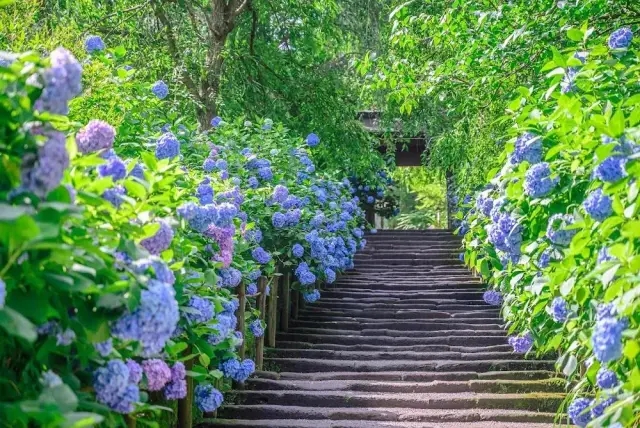https://www.dekitabi.com/itinerary/kita-kamakura-temple-tour
Kamakura, a serene city nestled in Kanagawa Prefecture, Japan, offers a rich tapestry of historical and cultural treasures. From ancient temples to bustling shopping streets, this charming destination is a perfect blend of spirituality and modernity. This guide takes you through some of the most notable spots in Kamakura: Kenchoji Temple, Mingyueyuan, Jochiji Temple, Tokeiji Temple, Tsurugaoka Hachimangu Shrine, and Komachi Street.
Kenchoji Temple: A Gateway to Zen Buddhism

https://www.dekitabi.com/attraction/kenchoji
Kenchoji Temple, founded in 1253, is one of Kamakura’s oldest and most significant Zen Buddhist temples. As the head temple of the Kenchoji branch of Rinzai Zen Buddhism, it holds immense historical and spiritual value. The temple’s grand entrance, the Sanmon Gate, welcomes visitors with its majestic wooden structure and intricate carvings.
Walking through Kenchoji Temple’s expansive grounds, you’ll encounter beautiful Zen gardens, ancient pine trees, and traditional Japanese architecture. The temple’s main hall, the Butsuden, houses a stunning statue of Shaka Nyorai (Sakyamuni Buddha). Don’t miss the beautiful Hojo, the abbot’s quarters, which offers a tranquil atmosphere perfect for contemplation.
Kenchoji Temple also features a unique Zen garden known as the “Tanzan Garden.” Its meticulously arranged rocks and gravel embody the essence of Zen simplicity. This serene space is ideal for reflecting on the principles of Zen Buddhism and enjoying the peaceful surroundings.
Mingyueyuan: Tranquility in the Heart of Kamakura

https://www.dekitabi.com/attraction/meigetsuin
Mingyueyuan, also known as the “Moonlight Garden,” is a hidden gem in Kamakura renowned for its tranquil atmosphere and beautiful landscapes. The garden’s name reflects its serene beauty, which is particularly enchanting during the moonlit nights.
The garden is meticulously landscaped, featuring traditional Japanese elements such as koi ponds, stone lanterns, and meticulously pruned bonsai trees. Mingyueyuan offers visitors a chance to escape the hustle and bustle of city life and immerse themselves in the serene beauty of nature. The garden’s harmonious design encourages mindfulness and relaxation, making it a perfect spot for meditation or a peaceful stroll.
Jochiji Temple: A Hidden Sanctuary of Kamakura

https://www.dekitabi.com/attraction/jochi-ji
Jochiji Temple, founded in 1280, is another prominent Zen Buddhist temple located in Kamakura. Known for its picturesque setting and serene atmosphere, Jochiji Temple is a wonderful place to explore Japan’s spiritual heritage.
The temple is renowned for its beautiful, well-preserved gardens and traditional architecture. The primary hall, or Hondo, houses a revered statue of Amida Buddha, which attracts many visitors seeking spiritual solace.
One of the highlights of Jochiji Temple is its stunning Zen garden, which features a variety of plant species and carefully designed landscapes. The garden’s peaceful ambiance offers a serene escape, allowing visitors to appreciate the beauty of Japanese garden design and experience a sense of inner calm.
Tokeiji Temple: A Sanctuary of Peace and Reflection

https://www.dekitabi.com/attraction/tokeiji
Tokeiji Temple, founded in 1285, is a temple with a unique history and tranquil environment. Originally established as a refuge for women seeking divorce, it later became a prominent Zen temple. Today, Tokeiji Temple is known for its serene gardens and historical significance.
The temple’s grounds are adorned with beautiful cherry blossoms in the spring, making it a picturesque destination for visitors. The main hall, or Hondo, is an elegant wooden structure that reflects traditional Japanese architectural style. Tokeiji Temple’s gardens are carefully landscaped, featuring lush greenery, tranquil ponds, and beautiful seasonal flowers.
Visitors to Tokeiji Temple can also explore the temple’s museum, which showcases artifacts and exhibits related to the temple’s history and Zen Buddhism. The peaceful atmosphere and beautiful surroundings make Tokeiji Temple a perfect place for contemplation and reflection.
Tsurugaoka Hachimangu Shrine: A Cultural and Spiritual Landmark

https://www.dekitabi.com/attraction/tsurugaoka-hachimangu-kamakura
Tsurugaoka Hachimangu Shrine is Kamakura’s most significant Shinto shrine, dedicated to Hachiman, the deity of war and protector of the Minamoto clan. Founded in 1063, the shrine has played a crucial role in Kamakura’s history and continues to be a center of spiritual and cultural activities.
The shrine’s grand entrance, the Wakamiya Oji, leads visitors to the main hall, where they can participate in traditional Shinto rituals and prayers. The expansive grounds of Tsurugaoka Hachimangu Shrine are adorned with beautiful gardens, historic buildings, and sacred trees. The vibrant red torii gates and the impressive stone staircases create a dramatic and memorable experience for visitors.
One of the shrine’s highlights is the annual Hachiman Matsuri, a festival that attracts thousands of visitors. The festival features traditional dances, processions, and ceremonies, offering a glimpse into Japan’s rich cultural heritage.
Komachi Street: A Vibrant Shopping and Dining Destination

https://www.dekitabi.com/attraction/komachidori-street
Komachi Street is a lively shopping district in Kamakura, known for its bustling atmosphere and diverse array of shops and eateries. This charming street is lined with traditional wooden storefronts, offering a mix of souvenirs, local crafts, and delicious street food.
As you stroll down Komachi Street, you’ll encounter a variety of shops selling everything from handmade jewelry and traditional Japanese crafts to delicious local snacks and sweets. The street is also home to numerous cafes and restaurants where you can sample authentic Japanese cuisine, including tempura, ramen, and matcha desserts.
Komachi Street is the perfect place to experience the vibrant energy of Kamakura while indulging in some retail therapy and culinary delights. The street’s lively ambiance and diverse offerings make it a popular destination for both locals and tourists alike.
Conclusion
Kamakura is a city that seamlessly blends its rich historical heritage with modern attractions. From the spiritual serenity of Kenchoji Temple and Tokeiji Temple to the tranquil beauty of Mingyueyuan and Jochiji Temple, there are numerous opportunities to explore Japan’s cultural and spiritual traditions. Tsurugaoka Hachimangu Shrine offers a glimpse into Kamakura’s historical significance, while Komachi Street provides a vibrant shopping and dining experience. Whether you’re seeking spiritual enlightenment or a taste of local culture, Kamakura has something to offer every traveler.
Exploring these sites will give you a deeper understanding of Kamakura’s unique charm and its place in Japan’s history and culture. Enjoy your journey through this captivating city, and let its timeless beauty and rich heritage leave a lasting impression.


Leave a Reply